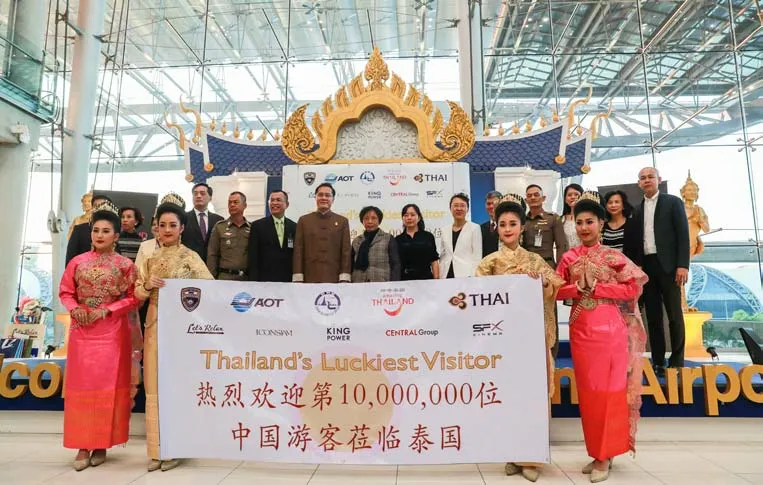CONNECTING THE DOTS OF A NEW WORLD LANDSCAPE
2019-09-03ByWangFengjuanShiGuang
By Wang Fengjuan, Shi Guang
Interview with Thai Prime Minister Prayut Chan-o-cha

Thai Prime Minister Prayut Chan-o-cha.
O n June 11, Chinese Premier Li Keqiang sent a telegram to Prayut Chan-o-cha to congratulate him on re-election as prime minister of the Kingdom of Thailand. In his congratulatory message, Li expressed belief that he would continue to lead the Thai people to improve the country. “China and Thailand are close neighbors and enjoy friendly relations,” Li remarked.“Cooperation between the two countries on jointly building the Belt and Road has been fruitful. I am ready to work with you to improve the China-Thailand traditional friendship,deepen comprehensive strategic cooperation and generate more benefits to the two peoples.”
Earlier, China Report ASEAN and Chinese media in Thailand jointly conducted an interview with Thailand's Prime Minister Prayut Chan-o-cha on both countries strengthening construction of the Belt and Road. Prayut Chan-o-cha believes that well-coordinated policy on connectivity is fundamental to changing the global landscape.
Connecting the Dots
China Report ASEAN: Could you please update us on Belt and Road cooperation between China and Thailand? What do you think the positive impacts of the Belt and Road have been?In which fields could Thailand and China strengthen future cooperation?
PM Prayut Chan-o-cha:The Belt and Road, an important initiative to stimulate economic growth in Asia and the world at large, has support from Thailand. The Belt and Road seeks to promote connectivity between Asia, Europe and Africa as well as closer relations between countries involved while boosting sustainable development through increased trade, investment and various projects involving connectivity.Thailand shares these objectives, which are similarly laid out in our 20-Year National Strategy and Thailand 4.0 as well as cooperation frameworks at the sub-regional and regional levels in which Thailand plays an active role.
Over the past five years, the Belt and Road Initiative (BRI)has been rapidly advancing.Numerous infrastructure projects, economic corridors and industrial parks in countries along the route funded by investments from China testify to its success.Belt and Road cooperation has expanded to areas beyond connectivity and economic development such as legal affairs, culture, energy, taxes and public health.

The Thailand Booth at the 24th China Kunming Import and Export Fair, which kicked off on June 12, 2016,at Kunming Dianchi International Convention and Exhibition Center in Kunming, capital of Yunnan Province.
Thailand is pleased that an increasing number of Chinese investors have expressed interest in the Eastern Economic Corridor(EEC) and encouraged by the progress made on the highspeed railway project between Thailand and China. During the Second Belt and Road Forum for International Cooperation(BRFIC), Thailand, China and Laos signed a Memorandum of Cooperation (MOC) on a railway between Thailand's Nongkhai and Vientiane in Laos. Because it is such an important route to connect China to Thailand and ASEAN, Thailand hopes this project will be finalized as soon as possible.
Belt and Road cooperation has expanded to areas beyond connectivity and economic development such as legal affairs,culture, energy, taxes and public health.
A priority for Thailand is building our digital economy by developing digital infrastructure and improving access to digital technology.In March 2019, Thailand and China met in Kunming, Yunnan Province, to promote bilateral cooperation in the digital field.
Thailand recognizes the important role of Southeast Asia in implementation of the BRI considering the region has six economic corridors that will link China with other regions.Given Thailand's strategic location at the center of Southeast Asia and the country's links to these six economic corridors, potential remains to expand Sino-Thai cooperation at the sub-regional and regional levels. This is particularly the case with the EEC, which will serve as a production and distribution base for exporting products to Cambodia, Laos,Myanmar and Vietnam. For this reason, Thailand is pleased that a bid from a conglomerate of Thai, Chinese, and Japanese companies won the contract to construct a high-speed railway linking three major airports:Don Mueang, Suvarnabhumi and U-Tapao.

Thailand's Tourism Ministry holds a ceremony at Suvarnabhumi Airport to welcome the 10 millionth Chinese tourist to arrive in Thailand on December 19, 2018.
In addition to the EEC,Thailand and China can jointly promote seamless connectivity between the Guangdong-Hong Kong-Macao Greater Bay Area (GBA) and the EEC and increase China's cooperation with the region by leveraging the attractive potential of the region's various frameworks and initiatives such as the Ayeyarwady-Chao Phraya-Mekong Economic Cooperation Strategy (ACMECS), Mekong-Lancang Cooperation and the Master Plan on ASEAN Connectivity 2025 (MPAC 2025).
Thailand considers connectivity one of the most crucial elements for sustainable development. Belt and Road cooperation will reduce logistics costs and facilitate exchange of people, innovation and best practices that will contribute to Thailand's efforts to “connect the connectivities” within the region. By working together and forging international partnerships, Thailand and China can jointly promote connectivity and sustainable development in the Mekong sub-region and beyond.
Intensive Exchanges
China Report ASEAN: The Thai people are endeavoring to promote “Connecting the Connectivities” to make Thailand a transportation hub of Southeast Asia. What role do you see the BRI playing towards this goal?
Prayut: As Chair of ASEAN in 2019, Thailand seeks to develop a seamless ASEAN through regional connectivity.In this regard, the MPAC 2025 will be our blueprint for implementation. Such connectivity includes both infrastructure development as well as rules and regulations harmonization. An increasingly connected ASEAN would boost the region's competitiveness and strengthen a sense of community and unity, enabling ASEAN to keep up with the everchanging world.
Furthermore, Thailand seeks to expand connectivity beyond ASEAN and has initiated the concept of “Connecting the Connectivities” to promote greater synergy between MPAC 2025 and key connectivity strategies of our partners such as the BRI and ACMECS Master Plan (2019-2023). This strategy will prove an important catalyst for ASEAN integration and regional prosperity and progress as we maintain security and promote regional connectivity.
Under the framework of the BRI, Thailand and ASEAN can collaborate with China in exchange of best practices and experience in areas such as harmonization of rules and regulations, digital innovation,people-to-people exchange,challenges of the fourth Industrial Revolution (4IR)and sustainable development.Furthermore, Thailand is keen to join hands with fellow ASEAN member states and China to increase activity between our peoples and strengthen peopleto-people relations. The year 2019 was thus designated as ASEAN-China Year of Media Exchange and Cultural Year of ASEAN.
Access to Global Value Chain
China Report ASEAN: In your opinion, what role has the BRI played in promoting a sound and steady recovery of the world economy over the five years since its inception?
Prayut: The BRI was designed with the aim to cope with various challenges amid the current context of globalization and other emerging challenges relating to the 4IR.
Thailand is pleased that the leaders who attended the First BRFIC in 2017 expressed intentions to promote and expand trade, support free trade and multilateral mechanisms and eliminate non-tariff trade barriers. They also expressed opposition to unilateralism and trade protectionism as well as support for connectivity between Asia, Europe, and Africa that is open and inclusive for all stakeholders.These are all important issues for economic growth and sustainable development that will promote the flow of raw materials, finished products and labor, thereby enabling countries along the Belt and Road to widen their access to the global value and supply chains.
Belt and Road Vision
China Report ASEAN: The Second BRFIC was held in Beijing from April 25 to 27,2019. What are your thoughts on the forum?
Prayut:The Second BRFIC provided opportunities for leaders from 38 countries to exchange points of view on collaboration under the BRI, enhance international relations and strengthen cooperation on sustainable and economic development.The Second BRFIC also enabled leaders to discuss the future direction of collaboration and served as another platform for Thailand to strengthen ASEAN's cooperation with China to promote connectivity in all dimensions.
Thailand plans to articulate our vision for work under the BRI such as efforts to boost competitiveness and expand market access of the private sector as well as our policy to facilitate trade, investment,and entrepreneurship among countries under the BRI.We would like to achieve sustainable funding for projects, promote public private partnerships, develop human resources, and promote the concept of “Connecting the Connectivities” under the ASEAN framework. Our strategy is to ensure that connectivity strategies across the wider region are synchronized and complementary to each other based on the principles of openness, inclusiveness and mutual benefits for sustainable security and development that leaves no one behind.
Building a New World Landscape
China Report ASEAN: The world is facing major changes and adjustments today. Against this backdrop, China is calling for building of the Belt and Road and a community of shared future for all mankind. What do you think about China's role in the international community?
Prayut:Thailand commends Chinese President Xi Jinping for launching the grand BRI as well as for his unwavering determination to pursue all related undertakings in support of this initiative. This reflects China's ambition to enhance regional cooperation and connectivity at the trans-continental scale and to promote sustainable development and the well-being of the people across the region and the world at large.
China's active engagement with the international community in developing the BRI, emphasizing extensive consultation, joint contributions and shared benefits, has created a sense of ownership among BRI members and a sustainable framework of cooperation. It has created a sense of strengthened multilateralism to address shared challenges in our current world of rapid and complex changes.
Considering that the BRI aims to link China with Asia,Europe and the rest of the world through policy coordination,facilities connectivity,unimpeded trade, financial integration and people-topeople bonds, we need to work closely together to synergize our development strategies in these areas to ensure they complement each other. Well-coordinated policy on connectivity is fundamental to a new world landscape—a landscape that respects domestic priorities of individual countries while ensuring major cross-border issues are addressed and global public goods are shared.
China-Thailand Railway
China Report ASEAN: What is your take on the China-Thailand railway project?
Prayut:The Thai government is committed to ensuring concrete progress of the China-Thailand railway project. As a Chinese proverb says, “Unity makes everything a success.”Thus, we are pleased that the project has made good progress and are excited for the opportunity to learn more about high-speed railways and related technology.
The China-Thailand railway project is strategically important for infrastructure connectivity and development.In addition to creating economic opportunities and encouraging mobility,the project will also be vital in increasing connectivity between China and ASEAN through the China-Laos railway and other economic corridors in the region such as the North-South Economic Corridor,Northern Economic Corridor and EEC.
An increasingly connected ASEAN would boost the region's competitiveness and strengthen a sense of community and unity.
